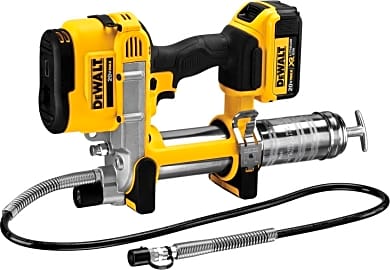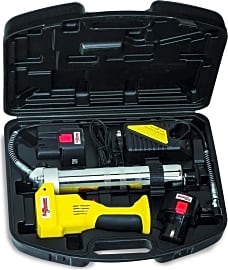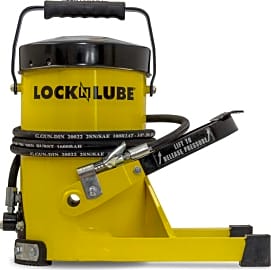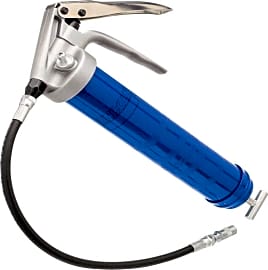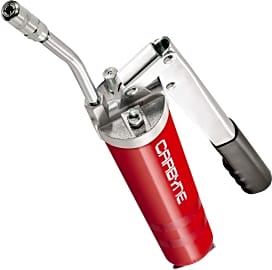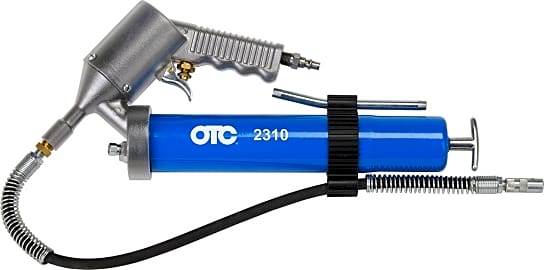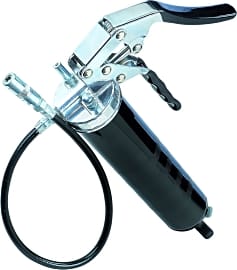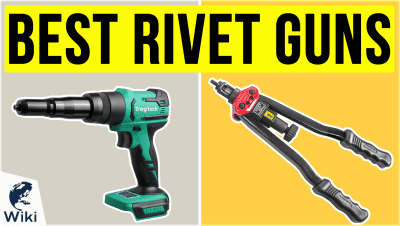The 10 Best Grease Guns

This wiki has been updated 42 times since it was first published in June of 2015. When you need to deliver a specific and consistent amount of lubricant, whether you're working at home in your garage or at a commercial auto shop, a quality grease gun will be your best friend. The models on our list range from simple, inexpensive, manual units that are perfect for hobbyists, all the way up to the pneumatic and electrically-powered implements used by professionals. When users buy our independently chosen editorial picks, we may earn commissions to help fund the Wiki.
Editor's Notes
May 27, 2021:
After doing a decent job of cleaning this list up last year, and without any noteworthy newcomers to dethrone any of our existing choices, we made it through this round of updates without making any major changes, believing that our existing selections continue to represent some of the best options in the category.
As the order of our rankings might suggest, we recommend a battery-powered model like the Milwaukee 2646-21CT M18 or DeWalt DCGG571M1, to those who can afford one, but we continue to retain several manual models closer to the bottom of our list, for users on a budget. The LocknLube GG80001 is a smart choice, if you’re working on heavy machinery and not afraid of bulk filling, while the Lincoln AC2440 is our suggestion for anybody looking for a corded model.
February 17, 2020:
During this round of updates, while most of our selections maintained their positions, we did replace Lincoln’s 12-volt and 18-volt models, the 1244 and 1844, with the company’s 20-volt offering, the Lincoln 1884 – which features a useful LCD screen to keep users advised of the tool’s battery life and issues alerts anytime it loses prime. We also decided to eliminate the Alemite 1056-SE4, observing that its expensive price seemed out of line with its basic design. Our other new additions were the Lumax LX-1176, a budget-friendly, battery-powered model that’s suitable for casual users who’re tired of the hand cramps that sometimes come with manual alternatives; and the LocknLube GG80001, a manual model that can be pumped by foot, features a ten-feet hose and is a great option for users who don’t mind bulk filling their grease.
A few factors to consider for this category:
Power Source: Tools in this category typically have one of four power sources:
Manual: These grease guns are powered by good-old-fashioned elbow grease. While models like the Lumax LX-1152 and Carbyne Lever Handle depend on users’ grip strength to manually pump the lubricant via trigger or lever, the LocknLube GG80001 sets itself apart by including a foot-operated pumping lever. Although these options can be reliable and affordable choices, operating them can be tiresome, and many professionals prefer to avoid them.
Pneumatic: In a manner similar to pneumatic sanders and pneumatic drills, pneumatic guns like the OTC 2310 harness the power of compressed air to dispense grease. Although options like these are considerably easier to handle than a manual model, they have the disadvantage of needing an air compressor to function – which might not be the biggest deal for users looking to outfit their mechanic shop, but will amount to an additional expense and/or inconvenience for others.
Electric: Models like the Lincoln AC2440, which plug into any common 120-volt wall outlet, are on par with pneumatic alternatives as far as ease of use goes, but they do have a big of edge in terms of versatility in that a wall outlet is often easier to come by than an air compressor. However, they still need to be plugged in, which won’t do you much good if you’re trying to service a machine parked way out in a field, for example.
Battery: Options like the DeWalt DCGG571M1 and Milwaukee 2646-21CT M18 are considered to be some of the best on the market, and use the same batteries as the companies’ other cordless tools, ultimately creating automatic, portable offerings that have the potential to save users a lot of time and hassle.
Loading Method: Most of our selections can accommodate grease tubes/cartridges, which many users prefer because of the relatively mess-free method’s simplicity. However, users who prefer to bulk fill their guns (an option that’s primarily tolerated because it’s considerably cheaper than tube filling) will likely appreciate options like the Carbyne Lever Handle and Lumax LX-1152, because they have provisions that allow them to be filled up via dispenser pumps. This is a much tidier method than bulk suction filling, which essentially involves dunking your barrel in a tub grease and yanking on its follower handle to suck grease up into its tube, effectively treating the gun like a giant syringe.
Output Pressure: While selections like the Carbyne Lever Handle and OTC 2310 generate smaller maximum output pressures of 4,000 PSI and 4,800 PSI, respectively, other models like the LocknLube GG80001 and Milwaukee 2646-21CT M18 can put out pressures as high as 10,000 PSI. Most users won’t require pressures that high. But, if you do have some high-pressure applications in mind it, it would be prudent to do a bit of research to ensure that the model you’re considering meets your needs. Also, be wary of flexible application hoses, as there have been reports of hoses having maximum pressure ratings that are less than that of the gun they come with.
Special Honors
Global Industrial Once you've got your gun picked out, you're going to need some lubricant to load it up with. Whether you're looking to pickup a pack of a dozen cartridges or a 400-pound barrel for bulk filling, this company has you covered, with options sorted into general purpose, industrial, and food grade categories. They keep plenty of guns in stock, too. globalindustrial.com
Grainger Whether you're looking for a manual, pneumatic or battery-powered model, this shop's got a big selection to choose from, and its website displays its options on a convenient table that makes it easy to compare some of their most important metrics. Conveniently, you can also filter results by fill method, and plenty of accessories and replacement parts are available, too. grainger.com
All About Grease Guns
For this reason is it important that lubrication technicians and home DIYers using a grease gun know how much grease their specific model outputs per stroke.
Grease guns are commonly used in automotive and industrial machining shops for greasing bearings and other parts that need regular lubrication. They are the most effective tool for moving grease to an application point in a controlled and localized manner. Grease guns most often come in three types; manual, pneumatic, and air powered, with manual models being the most affordable and widely used.
Different types of grease guns, and even different brands within the same type, will output a different amount of grease per stroke. Most grease guns output somewhere between one and three grams of grease per stroke. Over-greasing a bearing can cause the seals of a bearing to blow out, potentially allowing in dust and other contaminants, while under-greasing a bearing can lead to mechanical failure and overheating.
For this reason is it important that lubrication technicians and home DIYers using a grease gun know how much grease their specific model outputs per stroke. The actual output can also vary depending on the age of the grease gun, so it is important to periodically measure your grease gun's output. This can be done by performing a single stroke onto an electronic scale and weighing the amount of grease pushed out of the gun.
Manual grease guns may have either a lever or a trigger for hand-pumping the grease from the barrel to the hose or tube. The barrel is the area where the grease or grease cartridge is stored when inside of the gun. Some guns are designed to hold a pre-filled cartridge of grease while other models are designed to be filled with grease from a bulk container. Inside of the barrel is a plunger that gets depressed with a squeeze of the trigger or lever. This provides even pressure to the back of the grease tube or the grease itself to ensure a consistent output of grease.
On grease guns that accept exposed grease from a bulk container there will be a filler nipple, which is the injection point. On all models there will also be some kind of air-release valve to allow air to escape after adding new grease.
Attached to the barrel will be some kind of hydraulic coupler or connector that holds the flexible tube or fixed hose firmly in place when pumping grease. At the end of the hose or tube will be another coupler that connects to the application point.
Types Of Grease Guns Explained
As mentioned previously, there are three main types of grease guns; pneumatic, battery, and hand powered. Within the hand power category, there are both trigger, press, and lever style guns.
Lever style manual grease guns are the most commonly used types. They supply on average 1.28 grams of grease per pump. The lever runs along the length of the barrel. This can make them useful for applying grease in areas where there is no room to use a pistol grip style grease gun.
These are also very commonly used and can be found in most automotive shops and in many home DIYer garages.
Press style grease guns will have some kind of T-handle sticking out from the rear of the barrel which is designed to be depressed in some manner, either by brute force or through a twisting action.
Manual pistol grip grease guns allow for one-handed pumping so the user can keep one hand free for other purposes. These are also very commonly used and can be found in most automotive shops and in many home DIYer garages. A manual pistol grip gun outputs on average 0.86 grams of grease per stroke.
Pneumatic-powered grease guns only come with a pistol style grip and utilize positive displacement to dispense the grease. Pneumatic grease guns need to be attached to a hose during operation, which makes them inconvenient for some users. In addition to their high cost, they are also incredibly powerful and can easily blow out a bearing on smaller machine components. For these reasons they are generally only used in commercial and industrial applications.
Battery-powered grease guns also only come in a pistol grip and work in a similar manner to pneumatic models, the only difference being the power source. Battery-powered models have the advantage of cordless operation, making them more useful for those that need to move around a lot or work in an area where a cord running along the ground can be a hazard.
Tips For Using A Grease Gun
Following a few simple tips when using a grease can make your work more effective and also prevent any problems from arising. Make sure to use the vent plug when applying grease to allow air bubbles and old grease to escape. This will reduce the risk of applying too much pressure and blowing out the bearing.
Following a few simple tips when using a grease can make your work more effective and also prevent any problems from arising.
Another good idea is to install a grease fitting with a pressure relief valve. One must also be very careful when loading new cartridges to ensure that no contaminants are introduced to the system, as this can seriously shorten bearing life.
Before dispensing the grease, pump out a small amount onto a cloth or rag of some kind. This will clean the dispensing nozzle of any contaminants that might have gotten inside of it during storage. After dispensing a little bit, wipe the end of the nozzle off with a lint-free rag before attaching it to the application point.
The grease application point should also be cleaned with a lint-free rag before attaching the gun. After application wipe the injection point clean one more time before replacing the cap.



